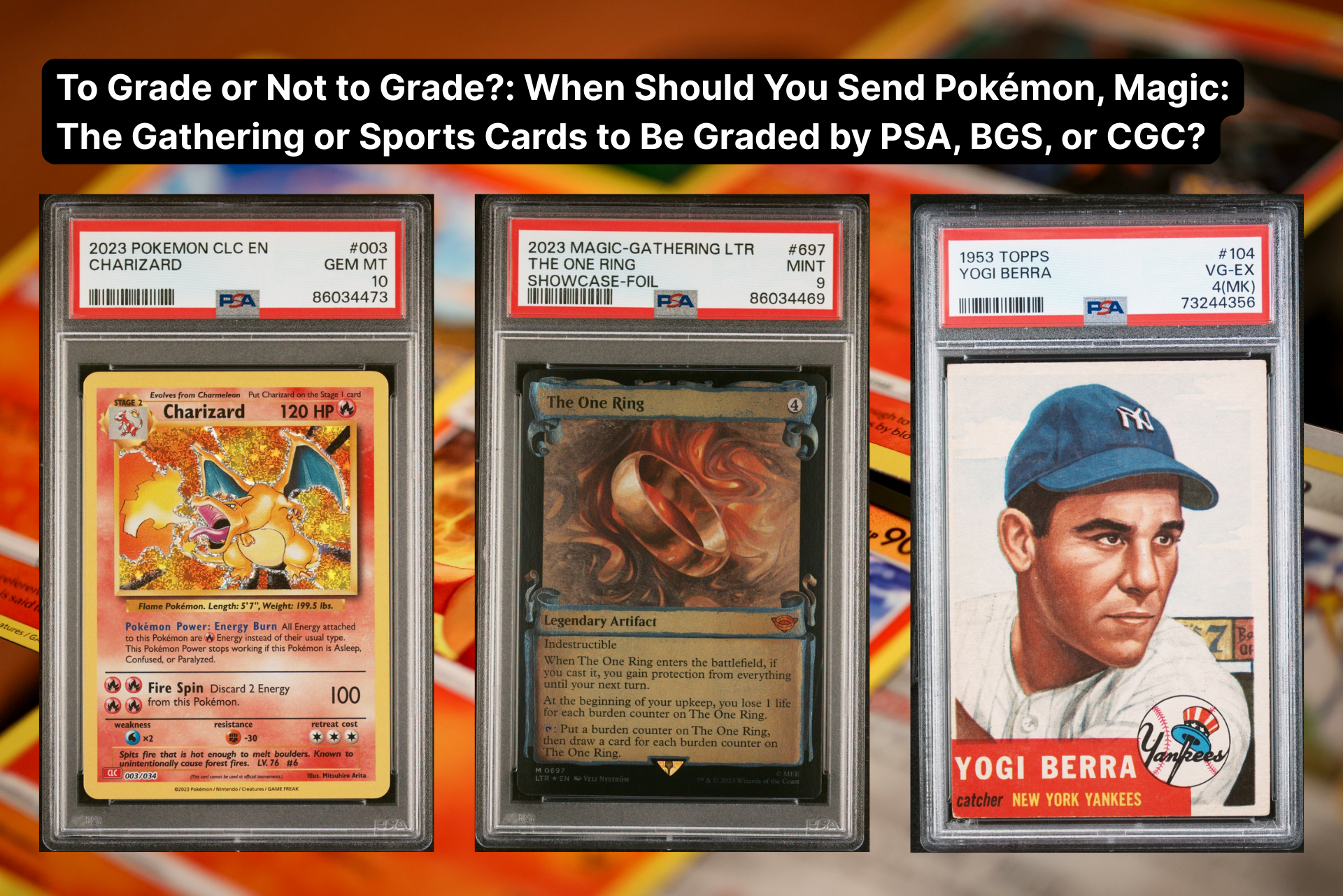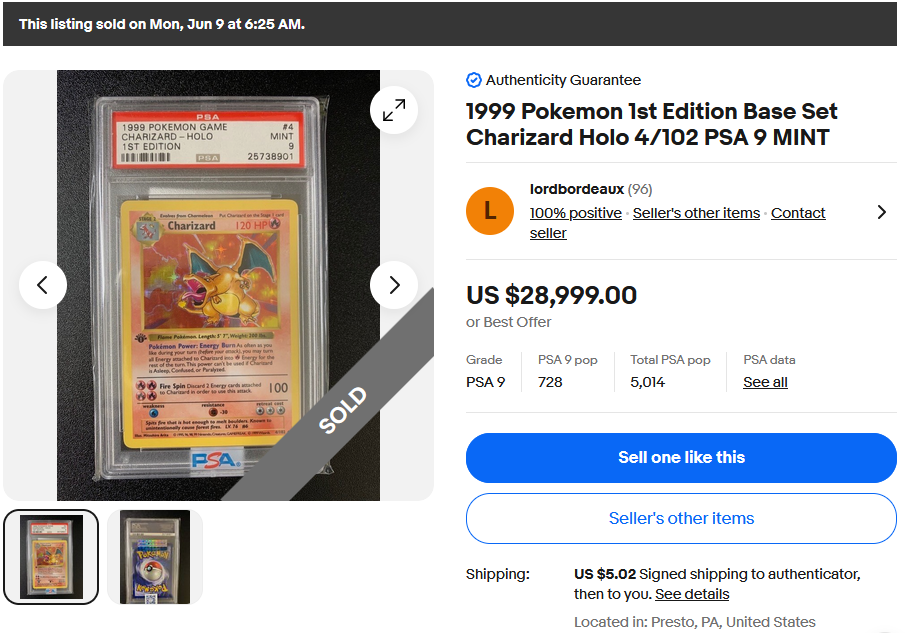To Grade or Not to Grade?: When Should You Send Pokemon, Magic: The Gathering or Sports Cards to Be Graded by PSA, BGS, or CGC?
Two beautiful graded cards we've sold in our eBay Store on the left and one card on the right in our personal collection that we also had graded.
What Does Grading Mean When Talking About Collectibles?
Grading collectibles refers to the process of authenticating a collectible item as real, and then assigning a “grade“ to that item based on its condition.
Different companies used different grading scales, but most have a large range from 1 to 10 (in the case of PSA), with a “1” indicating “Poor” condition and a “10“ indicating “Gem Mint“ condition, or an item that is in perfect condition.
If you think about how long collectibles have been around for, grading has had a relatively short history.
The most well-known grading company, Professional Sports Authenticator (PSA), was founded in 1991, and grading only really began a few years earlier for coins in 1985, with the founding of the Professional Coin Grading Service (PCGS).
Since the founding of PSA, other companies have entered the grading market, including Beckett Grading Services (BGS) in 1999 and the Certified Guaranty Company (CGC) in 2000.
BGS specializes in sports and trading cards, much like PSA, while CGC began by only grading comic books, and later started grading cards and other pop culture items, such as video games, magazines, and concert posters.
In the past two decades and especially around late 2020, interest in grading has skyrocketed, driven primarily by increased demand for graded trading cards, such as Pokemon, Yu Gi Oh, One Piece, and Magic: The Gathering cards.
Let’s dive into some specifics about grading collectibles, including (1) why you might want to grade your collectibles, (2) important considerations when grading collectibles, and (3) whether grading actually increases value (aka the price you’ll get if you want to sell).
Quick side note: If you have Pokemon cards to sell and want to get the most money for your collection, make sure to check out our recent article on How Much Are My Pokemon Cards Worth?: A Guide to Pricing and Selling Pokemon Cards.
Why Should I Grade My Collectibles?
Grading collectibles costs money (what doesn’t nowadays!) and doesn’t always make sense in all instances.
The prices for grading depends on multiple factors, including which company is chosen, the estimated value of the particular collectible item, and the turnaround time for the process of assessing authenticity and assigning the condition grade.
For example, at the time of writing the article, the price was $18.99 at PSA for grading a single trading card, and then getting the graded card mailed back in an estimate 65 business days.
If you want to get that same graded card returned to you in 5 business days, the price would be $149.00. Big difference!
So, if you need your 1st Edition Charizard card back soon to sell it while the market is hot or if you have an interested buyer, it might make sense to pay more, as opposed to a less valuable Spider Man comic you just want to make sure is actually real or prefer to be encased in a plastic grading slab for long-term safe keeping.
In the case of the Charizard, which recently sold for $28,999 on eBay (see photo below) for a PSA 9 graded version, paying $149.00 or more to get it back in 5 business days actually makes sense!
Interestingly, if you look at another sold listing on eBay from the same month (June, 2025) for an ungraded (aka raw or non-graded) version of this same exact 1st Edition Charizard card, the sale price was only $6,400.
Beyond a formal evaluation of the condition of a collectible item, grading also provides two key benefits.
First, as mentioned above, the professional(s) grading your item will first determine if the item is authentic (aka not fake).
The past few years especially have seen a dramatic rise in fake Pokemon, Magic: The Gathering, and Yu Gi Oh cards, so this step is crucial for determining if the item is actually real.
Working with reputable, high-rated sellers (like us with our 100% Positive Feedback score) on established marketplaces like eBay or Amazon can go a long way to making sure you get authentic cards, comic books or autographed sports memorabilia, whether you’re buying graded cards in slabs or raw cards that you want to send yourself for grading.
Second, regardless of the grading company, your item will be returned in a sonically-sealed hard plastic case with a label that shows the item name, grading company, and a certificate number that you can look up online to check authenticity and the quantity of that item in existence at that grade (i.e., the “population“).
This encapsulation process is the second benefit here — your card will be protected forever from UV light, moisture, dirt, dust, and scratches in the case.
Cards in grading slabs (aka cases) also look nice and are easier to organize and stack, or to display in your home or wherever you want to show them off (maybe at a bar or when you’re out with you buddies? Or not?).
The Bottom Line: Does Grading Collectibles Really Increase Value?
So, we’ve discussed what collectibles grading means, the history of collectibles grading, and when you should grade collectibles like trading cards or sports cards, but what about value?
Does grading collectibles always increase value?
Here’s the bottom line: grading cards almost always increases the value of a collectible item in the collectibles market, unless the condition grade is low.
It’s hard to tell exactly how much the grade will impact the ultimate sale price, but as you might expect, PSA 10 cards go for much more than PSA 9 cards, PSA 8 cards, etc.
When you get to lower grades like a 3, 4 or 5 (especially for modern sports or trading cards), the price for the graded card is often similar to or even lower than the raw price for that same card.
There are also some other considerations related to grading, value, and the specific game the item is from.
For example, in games where people actually like to play with their cards, such as Magic: The Gathering (MTG), grading does not often increase value, because people can’t put graded cards in their decks and play with them!
Original graphic from our Instagram Account @kendallsquarecollectibles.
Some exceptions to this rule for MTG exist of course, like the most sought-after card in the game, Black Lotus, which has sold for tens of thousands of dollars raw, and even more for PSA or CGC-graded versions, like a CGC Pristine 10 Alpha Black Lotus selling for $3 Million in 2024!
There you have it: our guide to what collectibles grading means, key reasons why you might want to grade your collectibles, and whether grading trading cards, sports cards, comic books and other collectibles actually increases their value.
As we discussed in a recent article on the Top Collectibles Trends in 2025, 2026, and Beyond, the collectibles market and especially the Pokemon (e.g., for real metal Pokemon cards) and trading card market is booming right now, so getting cards graded and sold might be a great idea!
We really appreciate you checking out this Knowledgebase article and we’re interested to hear your thoughts!
Do you have cards that you might want to get graded? Or have you have experience sending cards to be graded by PSA, BGS, CGC or other companies?
Let us know in the comments on this article, on our Instagram, Facebook page, or via email or DM!





